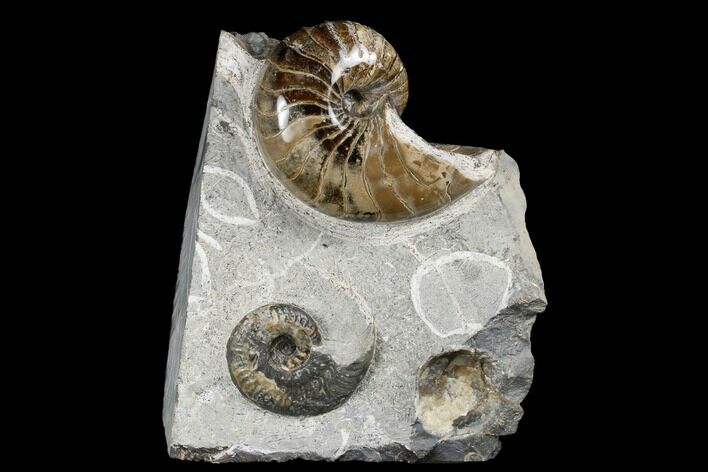This Specimen has been sold.
6.4" Polished Nautilus and Ammonite Fossil Association - England
This is a natural nautilus and ammonite fossil association that was collected from the Lower Jurassic age Falciferum Zone near Lincolnshire, England. The nautilus is of the species Cenoceras astacoides and the ammonite is of the species Harpoceras serpentinum. The shell of the nautilus fossil has been polished, away revealing the mineral replaced chambers. The fossils have been partially exposed from the hard limestone that they were found in, creating this aesthetic specimen.
The entire specimen measures 6.4 x 5.4" and the base has been cut flat for presentation purposes. The nautilus measures 3.7" wide and the ammonite is 2.2" wide.
The entire specimen measures 6.4 x 5.4" and the base has been cut flat for presentation purposes. The nautilus measures 3.7" wide and the ammonite is 2.2" wide.
About Ammonites
Ammonites were ancient marine cephalopods, similar to today's squids and octopuses, but with a defining feature: their distinctive, tightly coiled spiral shells. These shells, resembling those of modern nautiluses, served as both a protective home and a buoyancy aid, allowing ammonites to navigate the prehistoric seas with ease. First emerging around 240 million years ago in the Triassic Period, ammonites thrived for over 175 million years, adapting through numerous forms and sizes. As predatory creatures, they likely fed on smaller marine organisms, using their tentacles to capture prey. However, their long reign came to an end 65 million years ago at the close of the Cretaceous, coinciding with the mass extinction event that also eliminated the dinosaurs.
Ammonites were ancient marine cephalopods, similar to today's squids and octopuses, but with a defining feature: their distinctive, tightly coiled spiral shells. These shells, resembling those of modern nautiluses, served as both a protective home and a buoyancy aid, allowing ammonites to navigate the prehistoric seas with ease. First emerging around 240 million years ago in the Triassic Period, ammonites thrived for over 175 million years, adapting through numerous forms and sizes. As predatory creatures, they likely fed on smaller marine organisms, using their tentacles to capture prey. However, their long reign came to an end 65 million years ago at the close of the Cretaceous, coinciding with the mass extinction event that also eliminated the dinosaurs.
A nautilus's shell is made up of two layers. The inner layer has the iridescent shine, while the outer layer provides protection from external forces. Inside the shell are septa that divide the living area of the shell into compartments and help the animal maintain balance and position in the water column.
Nautilus are "living fossils": species similar to this one still exist in our oceans!
Nautilus are "living fossils": species similar to this one still exist in our oceans!
SPECIES
Cenoceras astacoides (Nautilus) & Harpoceras serpentinum (Ammonite)
LOCATION
Lincolnshire, England
FORMATION
Falciferum Zone, Upper Lias
SIZE
Entire specimen 6.4 x 5.4". Nautilus 3.7" wide
CATEGORY
SUB CATEGORY
ITEM
#180258
We guarantee the authenticity of all of our specimens.
 Reviews
Reviews















